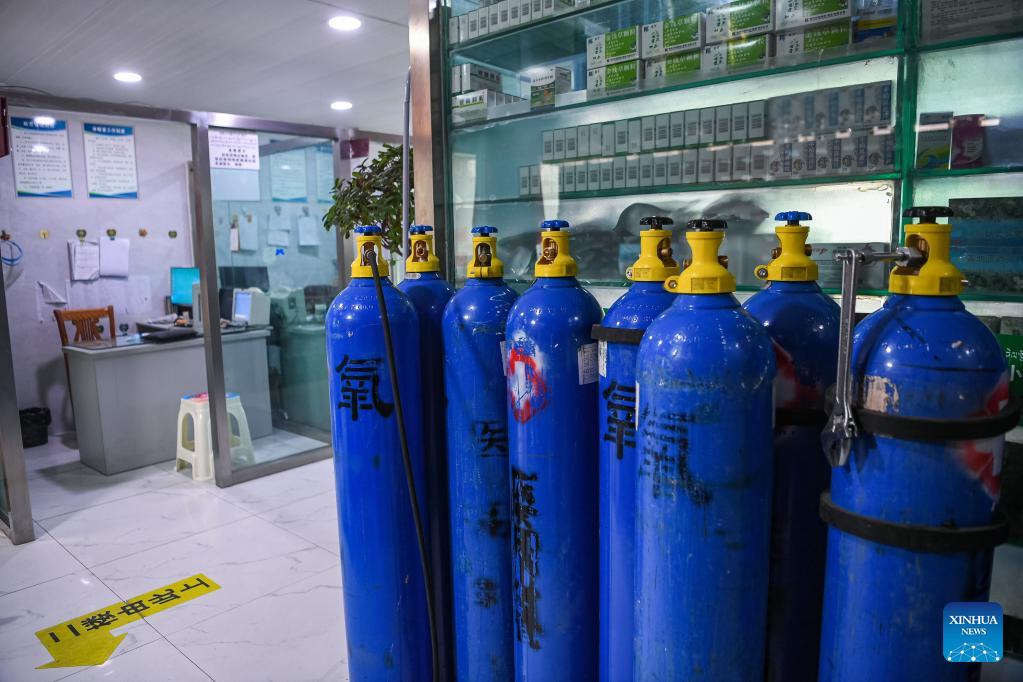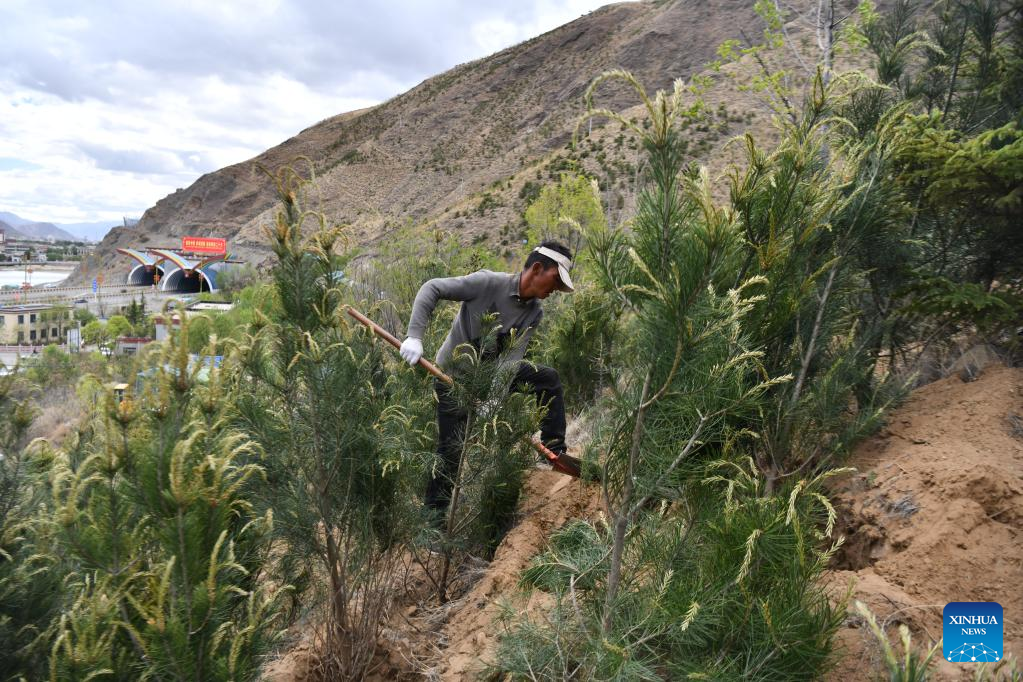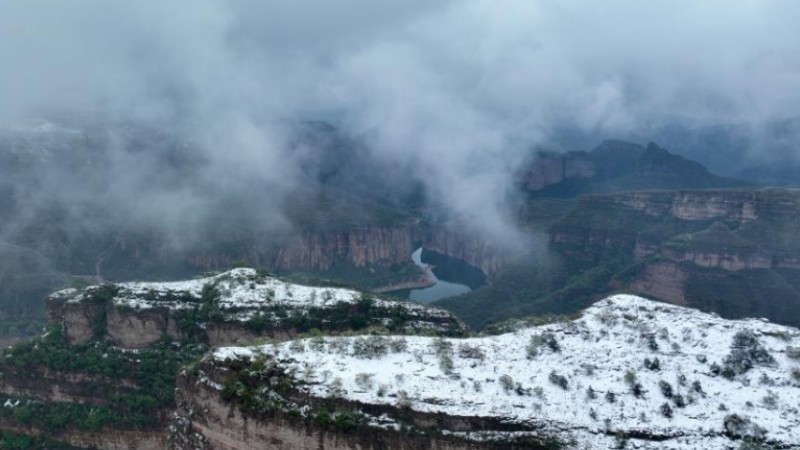Letter from Lhasa: All about oxygen

This photo taken on April 27, 2023 shows portable oxygen cylinders in a store in Lhasa, capital of southwest China's Tibet Autonomous Region. (Xinhua/Sun Fei)
LHASA, April 27 (Xinhua) -- While a person can only survive for a few minutes without oxygen, what happens when oxygen content in the air is only two-thirds of the normal level?
Hypoxia, a condition where the body doesn't receive enough oxygen, is a reality on the "roof of the world." In fact, as I write these words, I myself am using the oxygen supply system in my office to help me breathe.
As altitude increases, the amount of oxygen in the air declines due to the falling partial pressure. A mountaineering friend once told me that atop Mount Qomolangma, which stands at 8,848.86 meters, the amount of oxygen in the air is about one-third of that at sea level. In Lhasa, at an altitude of more than 3,600 meters, the oxygen content is about 65 percent of that at sea level.
A shortage of oxygen can cause mountain sickness and even be fatal. Mountain sickness is a syndrome that arises from an incomplete or maladaptive response to hypoxic conditions. Symptoms can range from mild to severe and may include headaches, dizziness, chest tightness, shortness of breath, palpitations, loss of appetite, nausea, vomiting, and impaired memory and cognitive abilities.
I have experienced them all to varying degrees. Fortunately, they did not develop into pulmonary edema or brain edema. Almost everyone I meet here experiences some sort of mountain sickness, including local Tibetans, though most of them have adapted well to the geographical conditions.
I once read an article in which scientists explained how a small set of gene variants enable Tibetans to enhance the efficiency of oxygen transport in their blood, without putting undue strain on their hearts. Upon learning this, I was filled with awe and admiration for my Tibetan friends and local residents. They have undergone an incredible transformation over countless generations, resulting in the unique and remarkable physical abilities they possess today.
Despite almost everyone advising me, a non-local, not to exercise strenuously on the plateau, I couldn't resist my habit of staying active. During my visit to some gyms in Lhasa, I was pleasantly surprised to find that most of them were equipped with diffused oxygen supply.
However, I still found that my strength training intensity wasn't on par with what I was used to in Beijing. Similarly, while swimming 1,000 meters of breaststroke, I found myself taking an additional 20 minutes to complete the distance.
Although oxygen is typically imperceptible to our senses, residing at the high altitudes of Tibet enables one to genuinely sense the presence of this vital and life-sustaining element.
As you stroll through the supermarket, it's hard to overlook the sight of bulging bags of chips, on the verge of bursting open and spilling their savory contents. And then there are the Tetra Pak containers of yogurt, meticulously stacked upside down, with their glued corners elegantly fanned out like wings. These intriguing scenes serve as a reminder that the air is thin here, and therefore, the amount of oxygen is lower than what we're accustomed to.
In addition to traditional yak jerky and intricate thangka paintings, there is a ubiquitous presence of a unique "local specialty" in this part of the world: portable oxygen. These life-sustaining cylinders can be purchased at convenience stores, tobacco and liquor shops, scenic spots, and even public restrooms.
In bustling cities like Lhasa, Shannan and Xigaze, oxygen cafes and clinics are easily accessible, offering tourists relief from altitude sickness through oxygen therapy.
With the plateau's geography proving to be a challenge, the local government has endeavored to devise innovative and resourceful methods to increase the oxygen supply and enhance the quality of life for residents.
According to this year's regional government work report, oxygen supply projects in border counties and towns above 3,500 meters will continue to be implemented. The regional finance department has raised over 2 billion yuan (about 289 million U.S. dollars) for such projects since 2016.
Apart from oxygen supply equipment, what could be a vital source of oxygen? Trees, of course! Thanks to the afforestation efforts, Tibet has witnessed a remarkable increase in tree coverage and the expansion of grasslands over the years.
The largest afforestation project in Tibet launched in 2021 is expected to complete the afforestation of more than 2 million mu (133,333 hectares) surrounding Lhasa by 2030.
The central government has spent 12.7 billion yuan on building an ecological security barrier in Tibet since 2012. The forest coverage rate has increased to 12.31 percent, and the comprehensive vegetation coverage of grassland has reached 47.14 percent.
Situated at approximately 4,500 meters above sea level, the city proper of Nagqu is known for its rarefied atmosphere, arid climate and sandy soil, devoid of naturally growing trees. After nearly two decades of efforts, a few trees have miraculously survived and are growing alongside roads.
However, in Nagqu's Tsonyi, China's highest county with an average altitude of over 5,000 meters, the sight of trees remains a luxury beyond reach.
I have been there once. Despite using my portable oxygen equipment, I found it hard to fall asleep at night because of the serious altitude sickness with headaches and palpitations.
Local doctors told me that painkillers have become a necessity for local residents to alleviate headaches and other symptoms of altitude sickness. I was astonished when I was told the children there were remarkably shorter than those in other parts of Tibet due to a lack of nutrition caused by the high altitude, in spite of eating nutritious food, such as meat, eggs and milk, at school every day.
In response, the regional government initiated a groundbreaking high-altitude ecological relocation program, resettling the residents from Tsonyi to Singpori, nestled on the north bank of the Yarlung Zangbo River in the city of Shannan, at an altitude of about 3,600 meters.
There are always more solutions than problems. In Tibet, I have witnessed the invaluable qualities exhibited by its people and government, such as creativity, accountability and unwavering courage in the face of adversity. It is clear that the Tibetans' resilience and indomitable spirit triumph over any obstacle.
In a remarkable feat of human adaptation to the low-oxygen environment, combined with improved living conditions and medical facilities, the average life expectancy in Tibet surged to 72.19 years in 2021, a significant rise from 35.5 years in 1951.
This serves as compelling evidence of the region's progress and development, paving the way for a healthier and more prosperous future for its residents.

This photo taken on April 27, 2023 shows medical oxygen cylinders at a clinic in Lhasa, capital of southwest China's Tibet Autonomous Region. (Xinhua/Sun Fei)

This photo taken on April 27, 2023 shows containers of yogurt stacked upside down in Lhasa, capital of southwest China's Tibet Autonomous Region. (Xinhua/Sun Fei)

This photo taken on April 27, 2023 shows a bulging bag of snack in Lhasa, capital of southwest China's Tibet Autonomous Region. (Xinhua/Sun Fei)

A man plants trees on a mountain in Lhasa, capital of southwest China's Tibet Autonomous Region, May 7, 2022. (Xinhua/Jigme Dorje)
Photos
Related Stories
- Tibet has over 9,500 5G base stations
- Top legislature mulls law on Qinghai-Tibet Plateau ecological conservation
- 13 monks receive doctoral degree equivalent in Tibetan Buddhism
- China emphasizes glacier, frozen soil protection on Qinghai-Tibet Plateau in new draft law
- A look at "paradise of wild animals" in China's Tibet
Copyright © 2023 People's Daily Online. All Rights Reserved.









